Global Leadership and Change
VerifiedAdded on 2023/04/23
|11
|2206
|404
AI Summary
The report aims at providing an insight into leadership plan in the context of global leadership and change. The report commences through identification of contingency theory of leadership that acts beneficial for the leadership role.
Contribute Materials
Your contribution can guide someone’s learning journey. Share your
documents today.
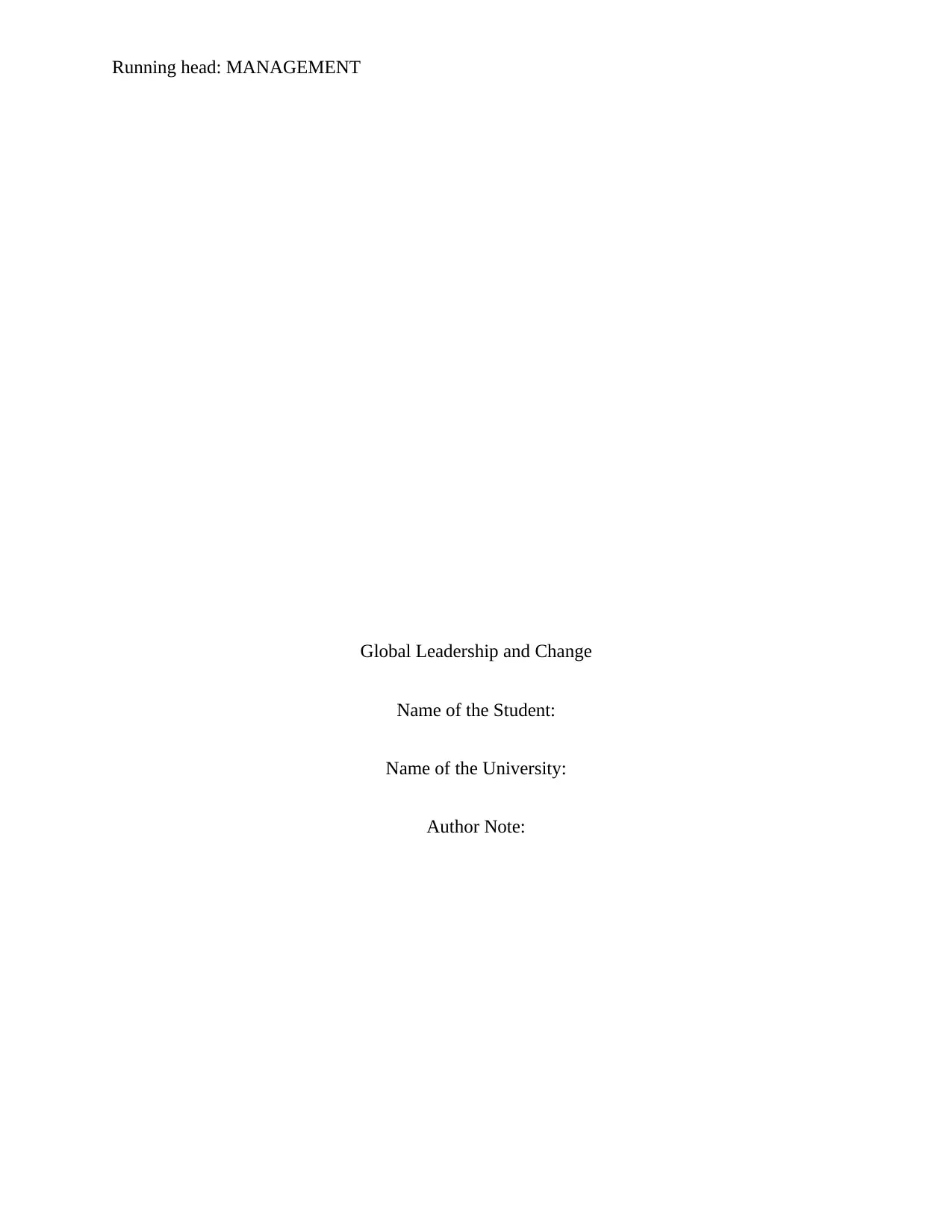
Running head: MANAGEMENT
Global Leadership and Change
Name of the Student:
Name of the University:
Author Note:
Global Leadership and Change
Name of the Student:
Name of the University:
Author Note:
Secure Best Marks with AI Grader
Need help grading? Try our AI Grader for instant feedback on your assignments.
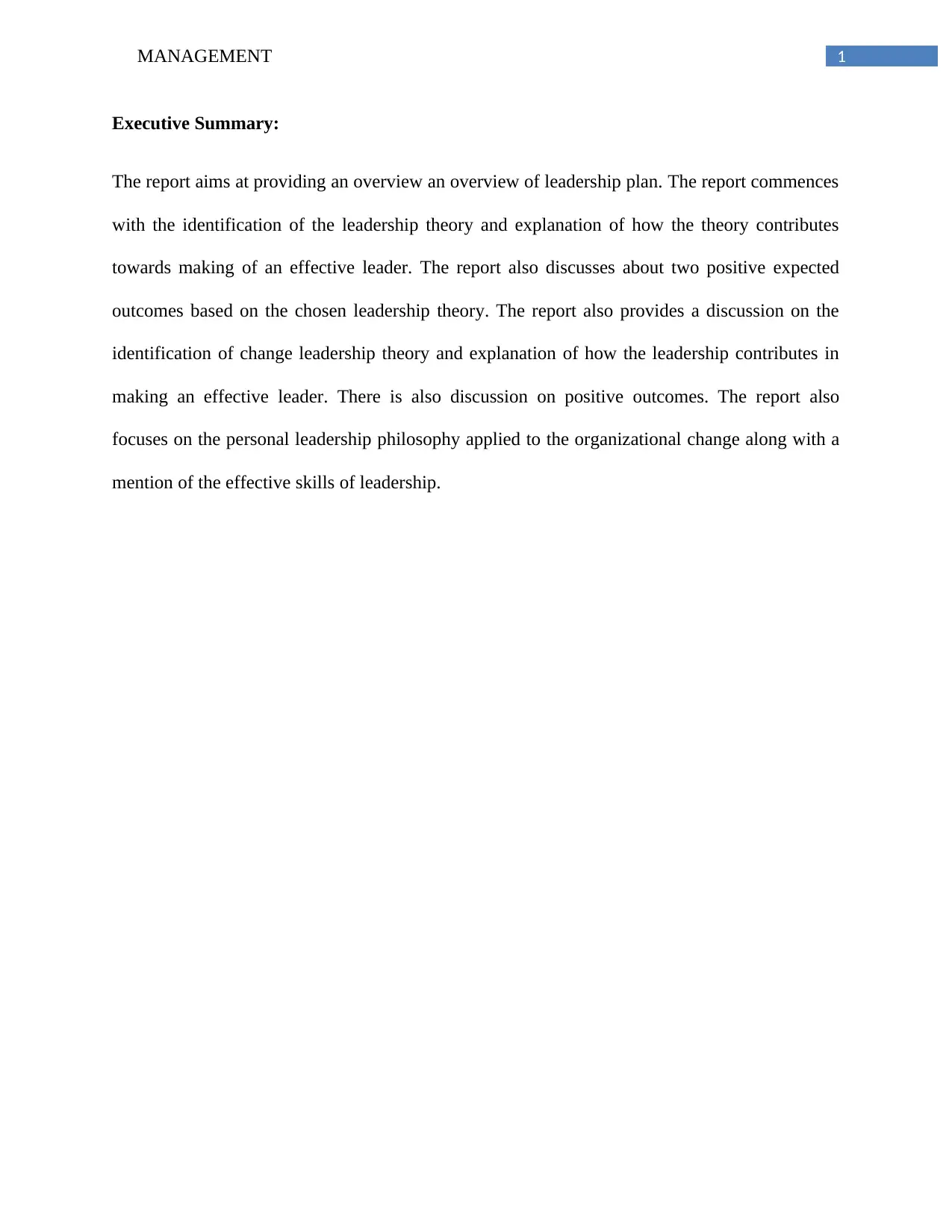
1MANAGEMENT
Executive Summary:
The report aims at providing an overview an overview of leadership plan. The report commences
with the identification of the leadership theory and explanation of how the theory contributes
towards making of an effective leader. The report also discusses about two positive expected
outcomes based on the chosen leadership theory. The report also provides a discussion on the
identification of change leadership theory and explanation of how the leadership contributes in
making an effective leader. There is also discussion on positive outcomes. The report also
focuses on the personal leadership philosophy applied to the organizational change along with a
mention of the effective skills of leadership.
Executive Summary:
The report aims at providing an overview an overview of leadership plan. The report commences
with the identification of the leadership theory and explanation of how the theory contributes
towards making of an effective leader. The report also discusses about two positive expected
outcomes based on the chosen leadership theory. The report also provides a discussion on the
identification of change leadership theory and explanation of how the leadership contributes in
making an effective leader. There is also discussion on positive outcomes. The report also
focuses on the personal leadership philosophy applied to the organizational change along with a
mention of the effective skills of leadership.
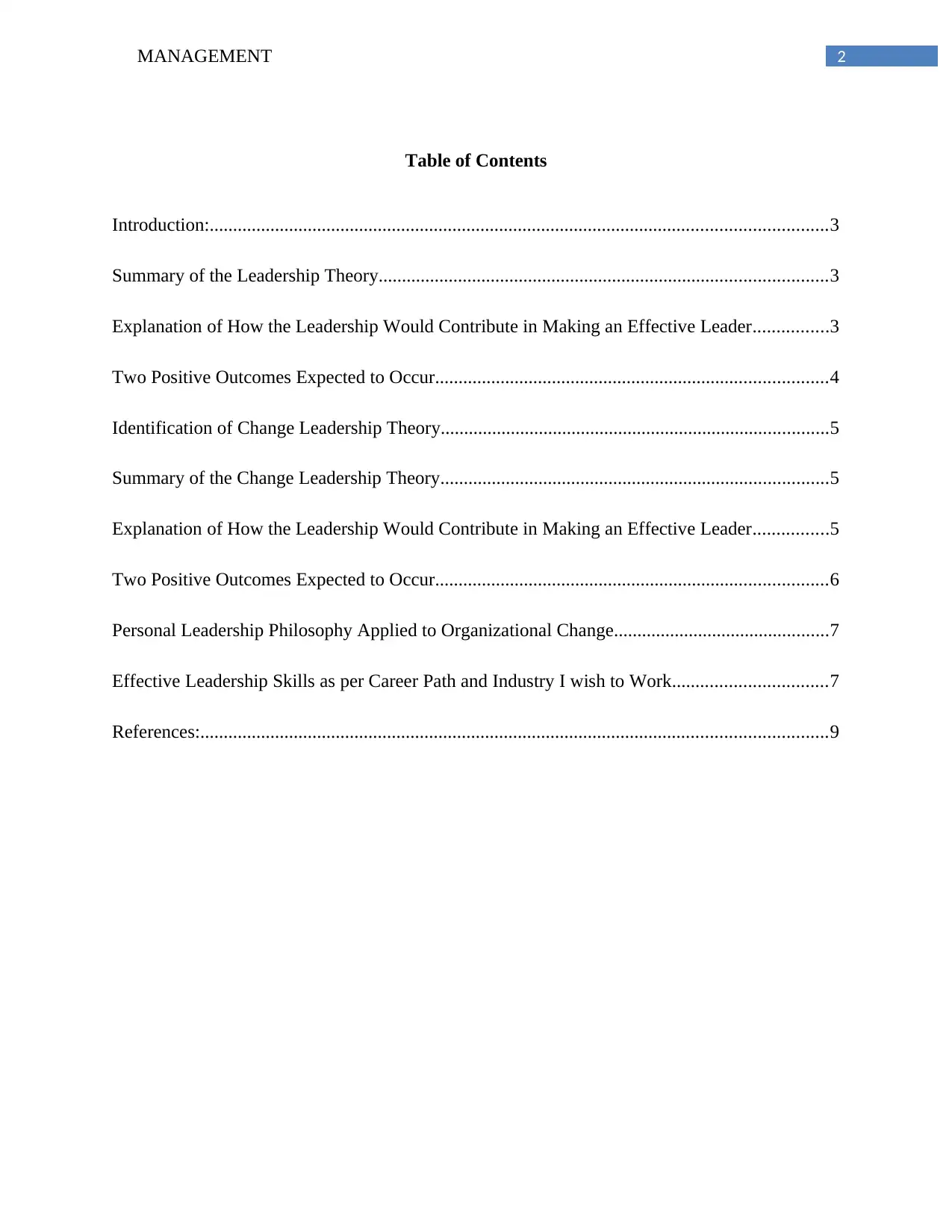
2MANAGEMENT
Table of Contents
Introduction:....................................................................................................................................3
Summary of the Leadership Theory................................................................................................3
Explanation of How the Leadership Would Contribute in Making an Effective Leader................3
Two Positive Outcomes Expected to Occur....................................................................................4
Identification of Change Leadership Theory...................................................................................5
Summary of the Change Leadership Theory...................................................................................5
Explanation of How the Leadership Would Contribute in Making an Effective Leader................5
Two Positive Outcomes Expected to Occur....................................................................................6
Personal Leadership Philosophy Applied to Organizational Change..............................................7
Effective Leadership Skills as per Career Path and Industry I wish to Work.................................7
References:......................................................................................................................................9
Table of Contents
Introduction:....................................................................................................................................3
Summary of the Leadership Theory................................................................................................3
Explanation of How the Leadership Would Contribute in Making an Effective Leader................3
Two Positive Outcomes Expected to Occur....................................................................................4
Identification of Change Leadership Theory...................................................................................5
Summary of the Change Leadership Theory...................................................................................5
Explanation of How the Leadership Would Contribute in Making an Effective Leader................5
Two Positive Outcomes Expected to Occur....................................................................................6
Personal Leadership Philosophy Applied to Organizational Change..............................................7
Effective Leadership Skills as per Career Path and Industry I wish to Work.................................7
References:......................................................................................................................................9
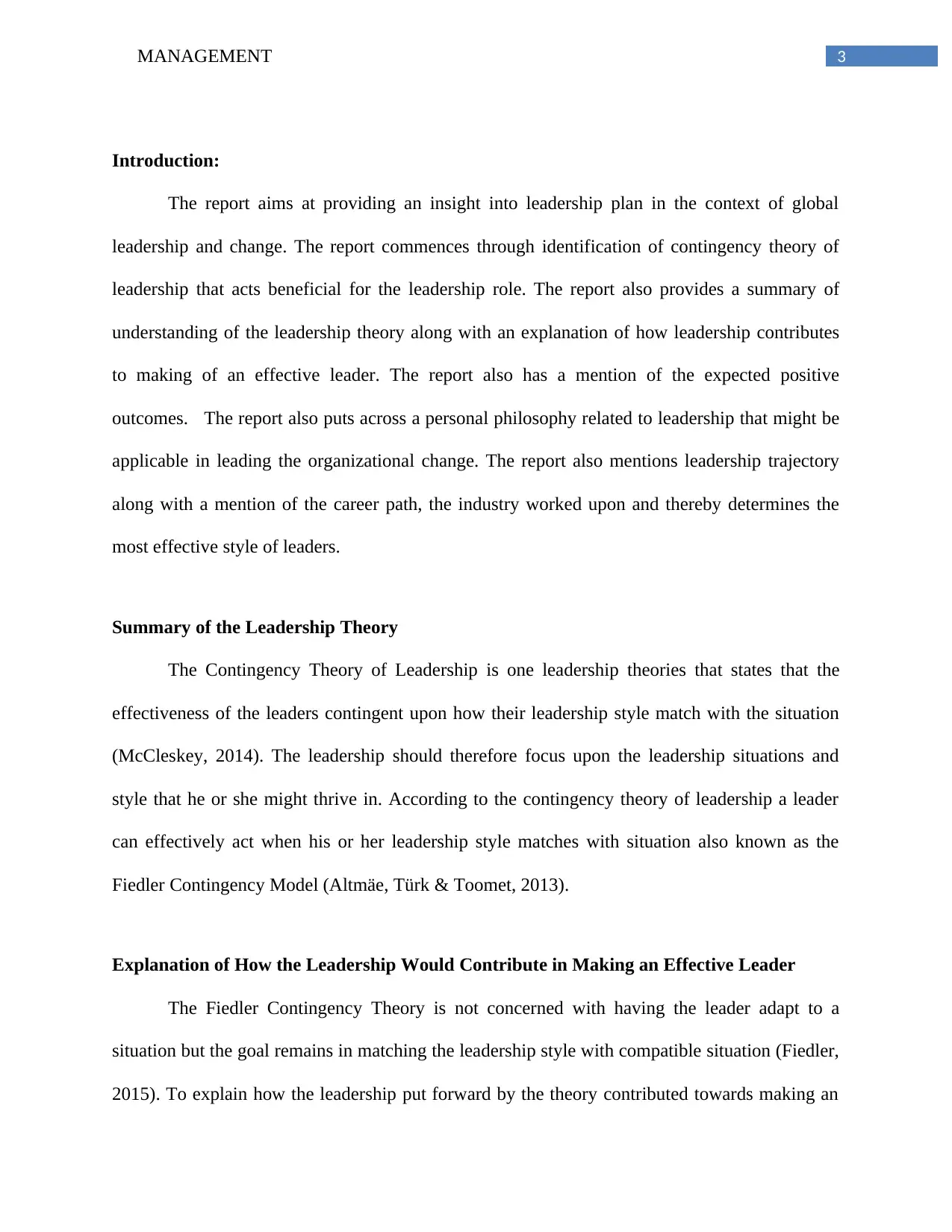
3MANAGEMENT
Introduction:
The report aims at providing an insight into leadership plan in the context of global
leadership and change. The report commences through identification of contingency theory of
leadership that acts beneficial for the leadership role. The report also provides a summary of
understanding of the leadership theory along with an explanation of how leadership contributes
to making of an effective leader. The report also has a mention of the expected positive
outcomes. The report also puts across a personal philosophy related to leadership that might be
applicable in leading the organizational change. The report also mentions leadership trajectory
along with a mention of the career path, the industry worked upon and thereby determines the
most effective style of leaders.
Summary of the Leadership Theory
The Contingency Theory of Leadership is one leadership theories that states that the
effectiveness of the leaders contingent upon how their leadership style match with the situation
(McCleskey, 2014). The leadership should therefore focus upon the leadership situations and
style that he or she might thrive in. According to the contingency theory of leadership a leader
can effectively act when his or her leadership style matches with situation also known as the
Fiedler Contingency Model (Altmäe, Türk & Toomet, 2013).
Explanation of How the Leadership Would Contribute in Making an Effective Leader
The Fiedler Contingency Theory is not concerned with having the leader adapt to a
situation but the goal remains in matching the leadership style with compatible situation (Fiedler,
2015). To explain how the leadership put forward by the theory contributed towards making an
Introduction:
The report aims at providing an insight into leadership plan in the context of global
leadership and change. The report commences through identification of contingency theory of
leadership that acts beneficial for the leadership role. The report also provides a summary of
understanding of the leadership theory along with an explanation of how leadership contributes
to making of an effective leader. The report also has a mention of the expected positive
outcomes. The report also puts across a personal philosophy related to leadership that might be
applicable in leading the organizational change. The report also mentions leadership trajectory
along with a mention of the career path, the industry worked upon and thereby determines the
most effective style of leaders.
Summary of the Leadership Theory
The Contingency Theory of Leadership is one leadership theories that states that the
effectiveness of the leaders contingent upon how their leadership style match with the situation
(McCleskey, 2014). The leadership should therefore focus upon the leadership situations and
style that he or she might thrive in. According to the contingency theory of leadership a leader
can effectively act when his or her leadership style matches with situation also known as the
Fiedler Contingency Model (Altmäe, Türk & Toomet, 2013).
Explanation of How the Leadership Would Contribute in Making an Effective Leader
The Fiedler Contingency Theory is not concerned with having the leader adapt to a
situation but the goal remains in matching the leadership style with compatible situation (Fiedler,
2015). To explain how the leadership put forward by the theory contributed towards making an
Secure Best Marks with AI Grader
Need help grading? Try our AI Grader for instant feedback on your assignments.
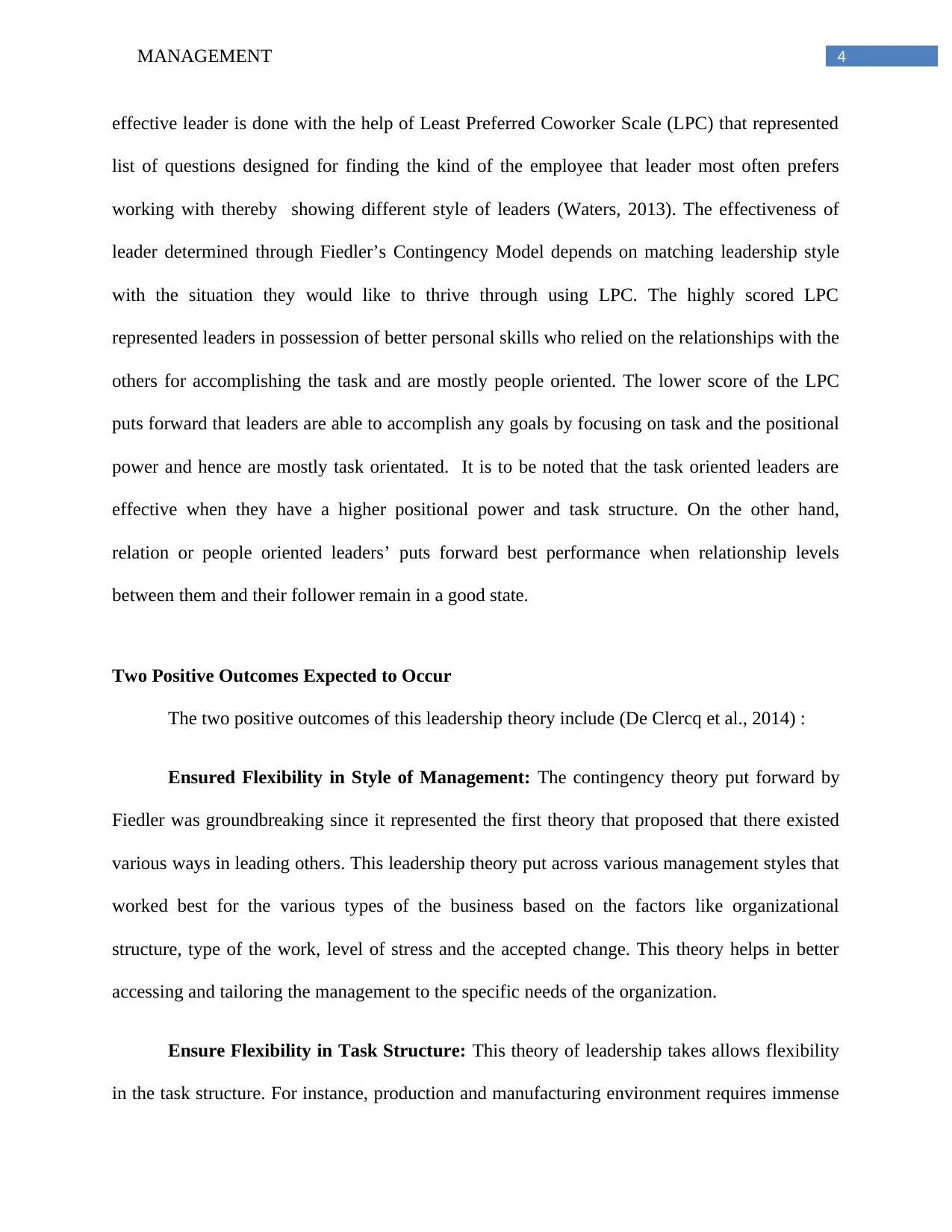
4MANAGEMENT
effective leader is done with the help of Least Preferred Coworker Scale (LPC) that represented
list of questions designed for finding the kind of the employee that leader most often prefers
working with thereby showing different style of leaders (Waters, 2013). The effectiveness of
leader determined through Fiedler’s Contingency Model depends on matching leadership style
with the situation they would like to thrive through using LPC. The highly scored LPC
represented leaders in possession of better personal skills who relied on the relationships with the
others for accomplishing the task and are mostly people oriented. The lower score of the LPC
puts forward that leaders are able to accomplish any goals by focusing on task and the positional
power and hence are mostly task orientated. It is to be noted that the task oriented leaders are
effective when they have a higher positional power and task structure. On the other hand,
relation or people oriented leaders’ puts forward best performance when relationship levels
between them and their follower remain in a good state.
Two Positive Outcomes Expected to Occur
The two positive outcomes of this leadership theory include (De Clercq et al., 2014) :
Ensured Flexibility in Style of Management: The contingency theory put forward by
Fiedler was groundbreaking since it represented the first theory that proposed that there existed
various ways in leading others. This leadership theory put across various management styles that
worked best for the various types of the business based on the factors like organizational
structure, type of the work, level of stress and the accepted change. This theory helps in better
accessing and tailoring the management to the specific needs of the organization.
Ensure Flexibility in Task Structure: This theory of leadership takes allows flexibility
in the task structure. For instance, production and manufacturing environment requires immense
effective leader is done with the help of Least Preferred Coworker Scale (LPC) that represented
list of questions designed for finding the kind of the employee that leader most often prefers
working with thereby showing different style of leaders (Waters, 2013). The effectiveness of
leader determined through Fiedler’s Contingency Model depends on matching leadership style
with the situation they would like to thrive through using LPC. The highly scored LPC
represented leaders in possession of better personal skills who relied on the relationships with the
others for accomplishing the task and are mostly people oriented. The lower score of the LPC
puts forward that leaders are able to accomplish any goals by focusing on task and the positional
power and hence are mostly task orientated. It is to be noted that the task oriented leaders are
effective when they have a higher positional power and task structure. On the other hand,
relation or people oriented leaders’ puts forward best performance when relationship levels
between them and their follower remain in a good state.
Two Positive Outcomes Expected to Occur
The two positive outcomes of this leadership theory include (De Clercq et al., 2014) :
Ensured Flexibility in Style of Management: The contingency theory put forward by
Fiedler was groundbreaking since it represented the first theory that proposed that there existed
various ways in leading others. This leadership theory put across various management styles that
worked best for the various types of the business based on the factors like organizational
structure, type of the work, level of stress and the accepted change. This theory helps in better
accessing and tailoring the management to the specific needs of the organization.
Ensure Flexibility in Task Structure: This theory of leadership takes allows flexibility
in the task structure. For instance, production and manufacturing environment requires immense
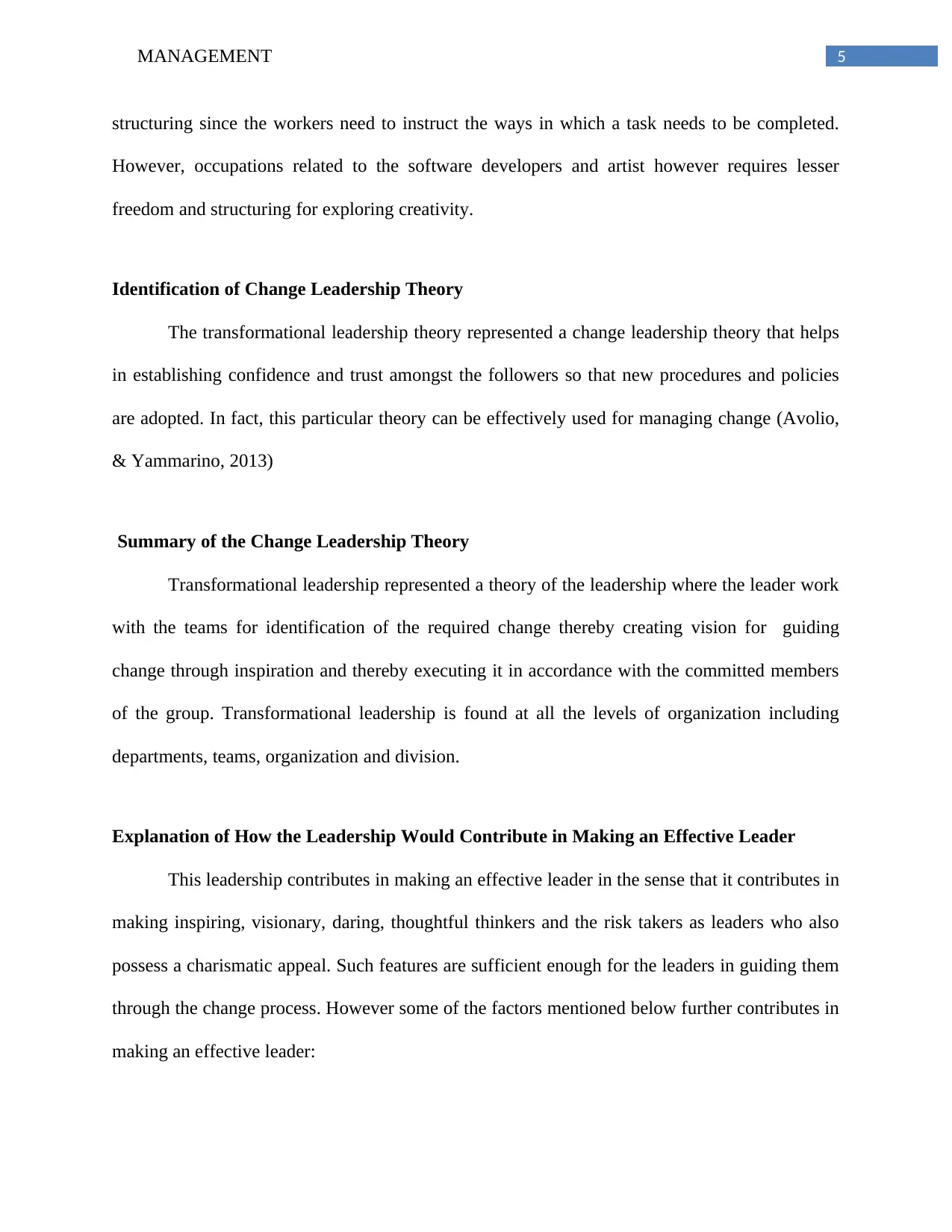
5MANAGEMENT
structuring since the workers need to instruct the ways in which a task needs to be completed.
However, occupations related to the software developers and artist however requires lesser
freedom and structuring for exploring creativity.
Identification of Change Leadership Theory
The transformational leadership theory represented a change leadership theory that helps
in establishing confidence and trust amongst the followers so that new procedures and policies
are adopted. In fact, this particular theory can be effectively used for managing change (Avolio,
& Yammarino, 2013)
Summary of the Change Leadership Theory
Transformational leadership represented a theory of the leadership where the leader work
with the teams for identification of the required change thereby creating vision for guiding
change through inspiration and thereby executing it in accordance with the committed members
of the group. Transformational leadership is found at all the levels of organization including
departments, teams, organization and division.
Explanation of How the Leadership Would Contribute in Making an Effective Leader
This leadership contributes in making an effective leader in the sense that it contributes in
making inspiring, visionary, daring, thoughtful thinkers and the risk takers as leaders who also
possess a charismatic appeal. Such features are sufficient enough for the leaders in guiding them
through the change process. However some of the factors mentioned below further contributes in
making an effective leader:
structuring since the workers need to instruct the ways in which a task needs to be completed.
However, occupations related to the software developers and artist however requires lesser
freedom and structuring for exploring creativity.
Identification of Change Leadership Theory
The transformational leadership theory represented a change leadership theory that helps
in establishing confidence and trust amongst the followers so that new procedures and policies
are adopted. In fact, this particular theory can be effectively used for managing change (Avolio,
& Yammarino, 2013)
Summary of the Change Leadership Theory
Transformational leadership represented a theory of the leadership where the leader work
with the teams for identification of the required change thereby creating vision for guiding
change through inspiration and thereby executing it in accordance with the committed members
of the group. Transformational leadership is found at all the levels of organization including
departments, teams, organization and division.
Explanation of How the Leadership Would Contribute in Making an Effective Leader
This leadership contributes in making an effective leader in the sense that it contributes in
making inspiring, visionary, daring, thoughtful thinkers and the risk takers as leaders who also
possess a charismatic appeal. Such features are sufficient enough for the leaders in guiding them
through the change process. However some of the factors mentioned below further contributes in
making an effective leader:
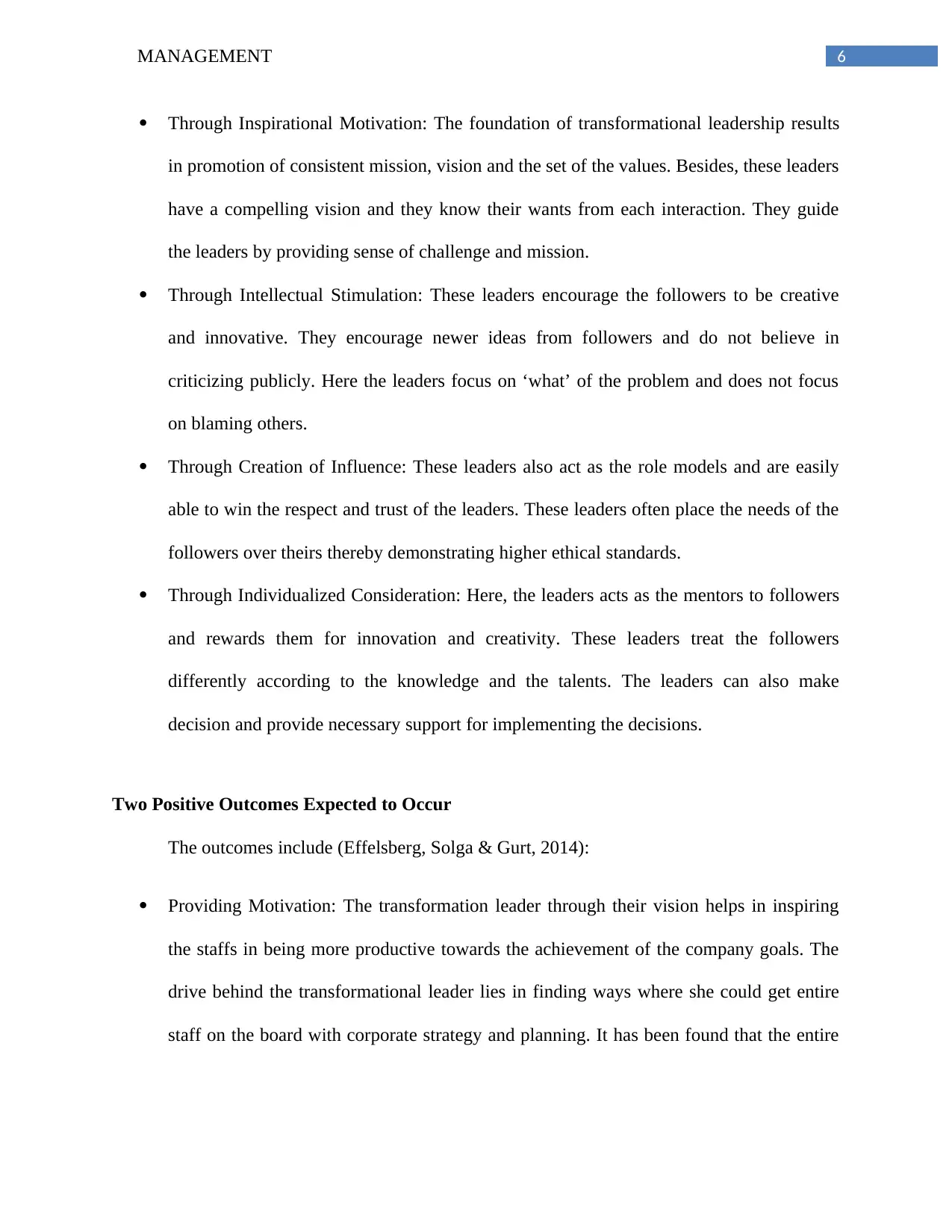
6MANAGEMENT
Through Inspirational Motivation: The foundation of transformational leadership results
in promotion of consistent mission, vision and the set of the values. Besides, these leaders
have a compelling vision and they know their wants from each interaction. They guide
the leaders by providing sense of challenge and mission.
Through Intellectual Stimulation: These leaders encourage the followers to be creative
and innovative. They encourage newer ideas from followers and do not believe in
criticizing publicly. Here the leaders focus on ‘what’ of the problem and does not focus
on blaming others.
Through Creation of Influence: These leaders also act as the role models and are easily
able to win the respect and trust of the leaders. These leaders often place the needs of the
followers over theirs thereby demonstrating higher ethical standards.
Through Individualized Consideration: Here, the leaders acts as the mentors to followers
and rewards them for innovation and creativity. These leaders treat the followers
differently according to the knowledge and the talents. The leaders can also make
decision and provide necessary support for implementing the decisions.
Two Positive Outcomes Expected to Occur
The outcomes include (Effelsberg, Solga & Gurt, 2014):
Providing Motivation: The transformation leader through their vision helps in inspiring
the staffs in being more productive towards the achievement of the company goals. The
drive behind the transformational leader lies in finding ways where she could get entire
staff on the board with corporate strategy and planning. It has been found that the entire
Through Inspirational Motivation: The foundation of transformational leadership results
in promotion of consistent mission, vision and the set of the values. Besides, these leaders
have a compelling vision and they know their wants from each interaction. They guide
the leaders by providing sense of challenge and mission.
Through Intellectual Stimulation: These leaders encourage the followers to be creative
and innovative. They encourage newer ideas from followers and do not believe in
criticizing publicly. Here the leaders focus on ‘what’ of the problem and does not focus
on blaming others.
Through Creation of Influence: These leaders also act as the role models and are easily
able to win the respect and trust of the leaders. These leaders often place the needs of the
followers over theirs thereby demonstrating higher ethical standards.
Through Individualized Consideration: Here, the leaders acts as the mentors to followers
and rewards them for innovation and creativity. These leaders treat the followers
differently according to the knowledge and the talents. The leaders can also make
decision and provide necessary support for implementing the decisions.
Two Positive Outcomes Expected to Occur
The outcomes include (Effelsberg, Solga & Gurt, 2014):
Providing Motivation: The transformation leader through their vision helps in inspiring
the staffs in being more productive towards the achievement of the company goals. The
drive behind the transformational leader lies in finding ways where she could get entire
staff on the board with corporate strategy and planning. It has been found that the entire
Paraphrase This Document
Need a fresh take? Get an instant paraphrase of this document with our AI Paraphraser
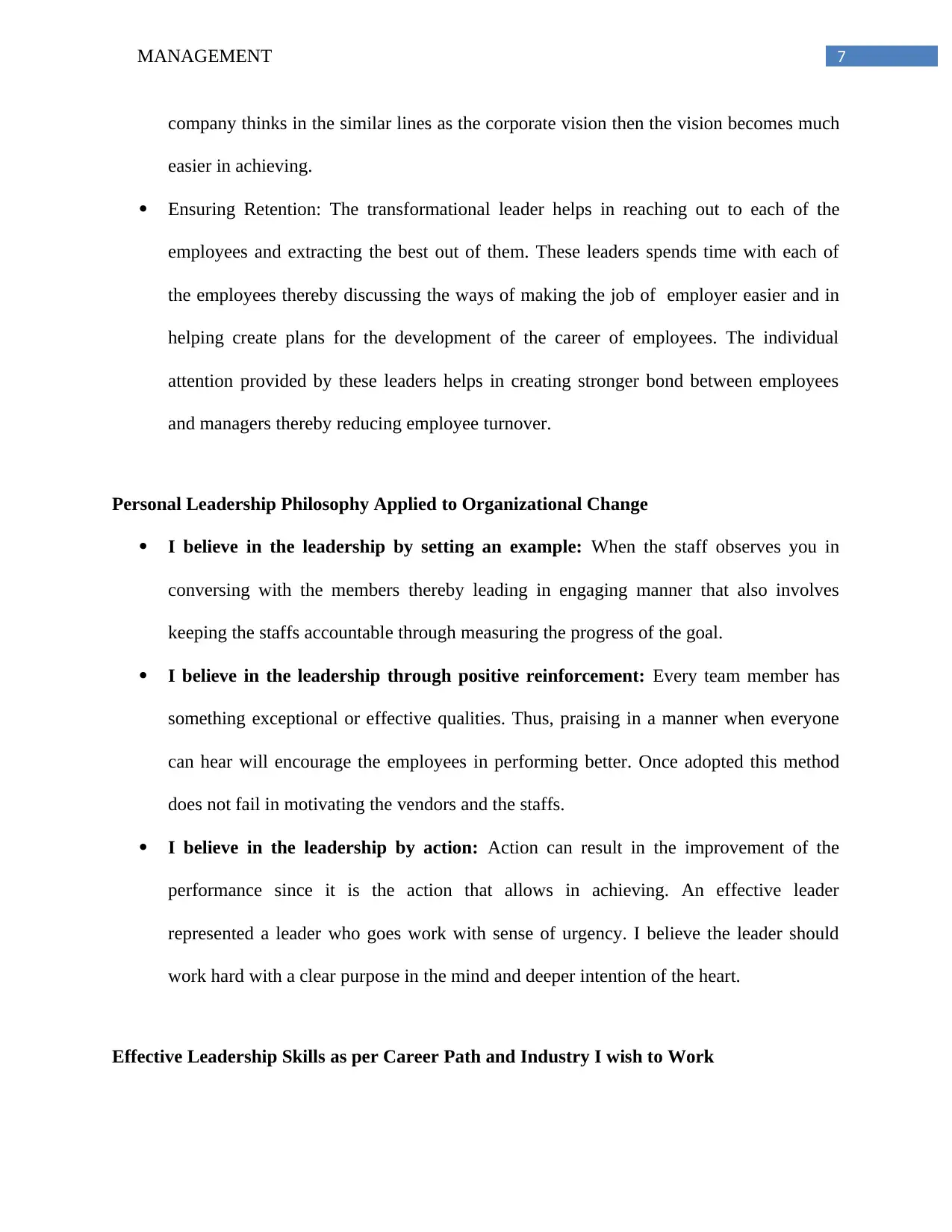
7MANAGEMENT
company thinks in the similar lines as the corporate vision then the vision becomes much
easier in achieving.
Ensuring Retention: The transformational leader helps in reaching out to each of the
employees and extracting the best out of them. These leaders spends time with each of
the employees thereby discussing the ways of making the job of employer easier and in
helping create plans for the development of the career of employees. The individual
attention provided by these leaders helps in creating stronger bond between employees
and managers thereby reducing employee turnover.
Personal Leadership Philosophy Applied to Organizational Change
I believe in the leadership by setting an example: When the staff observes you in
conversing with the members thereby leading in engaging manner that also involves
keeping the staffs accountable through measuring the progress of the goal.
I believe in the leadership through positive reinforcement: Every team member has
something exceptional or effective qualities. Thus, praising in a manner when everyone
can hear will encourage the employees in performing better. Once adopted this method
does not fail in motivating the vendors and the staffs.
I believe in the leadership by action: Action can result in the improvement of the
performance since it is the action that allows in achieving. An effective leader
represented a leader who goes work with sense of urgency. I believe the leader should
work hard with a clear purpose in the mind and deeper intention of the heart.
Effective Leadership Skills as per Career Path and Industry I wish to Work
company thinks in the similar lines as the corporate vision then the vision becomes much
easier in achieving.
Ensuring Retention: The transformational leader helps in reaching out to each of the
employees and extracting the best out of them. These leaders spends time with each of
the employees thereby discussing the ways of making the job of employer easier and in
helping create plans for the development of the career of employees. The individual
attention provided by these leaders helps in creating stronger bond between employees
and managers thereby reducing employee turnover.
Personal Leadership Philosophy Applied to Organizational Change
I believe in the leadership by setting an example: When the staff observes you in
conversing with the members thereby leading in engaging manner that also involves
keeping the staffs accountable through measuring the progress of the goal.
I believe in the leadership through positive reinforcement: Every team member has
something exceptional or effective qualities. Thus, praising in a manner when everyone
can hear will encourage the employees in performing better. Once adopted this method
does not fail in motivating the vendors and the staffs.
I believe in the leadership by action: Action can result in the improvement of the
performance since it is the action that allows in achieving. An effective leader
represented a leader who goes work with sense of urgency. I believe the leader should
work hard with a clear purpose in the mind and deeper intention of the heart.
Effective Leadership Skills as per Career Path and Industry I wish to Work

8MANAGEMENT
I wish to be a part of the manufacturing sector and so the leadership skills that would be
the most effective include (Weisband, 2013):
By Being an Active Listener: One of the skills necessary for becoming a business leader
lies in the ability to actively listen to the challenges put forward by the employees and work with
them in correcting the areas causing problems.
Through Continuous Self Improvement: Effective leaders should focus on the constant
improvement and development of the employees and the company. Good leaders not only strive
for newer knowledge but possess the ability of implementing the ideas.
By Being Emotionally Aware: As leaders it is necessary to possess certain amount of
emotional intelligence that implies being sensitive towards the different backgrounds and the
different points of view.
Through Undertaking Proper Communication: Excellent communication skills are
necessary in striving to become better business leader. This is all the more important in the
business environment of today where there lies very little room for ambiguity as the audience
believes in making their own interpretations.
By Leading through Example: As a leader, it is vital to show the employees how
implementing something holds more importance than simply telling them. As a leader wants
their staffs to be punctual then it is the leader who should be more punctual before guiding
others.
I wish to be a part of the manufacturing sector and so the leadership skills that would be
the most effective include (Weisband, 2013):
By Being an Active Listener: One of the skills necessary for becoming a business leader
lies in the ability to actively listen to the challenges put forward by the employees and work with
them in correcting the areas causing problems.
Through Continuous Self Improvement: Effective leaders should focus on the constant
improvement and development of the employees and the company. Good leaders not only strive
for newer knowledge but possess the ability of implementing the ideas.
By Being Emotionally Aware: As leaders it is necessary to possess certain amount of
emotional intelligence that implies being sensitive towards the different backgrounds and the
different points of view.
Through Undertaking Proper Communication: Excellent communication skills are
necessary in striving to become better business leader. This is all the more important in the
business environment of today where there lies very little room for ambiguity as the audience
believes in making their own interpretations.
By Leading through Example: As a leader, it is vital to show the employees how
implementing something holds more importance than simply telling them. As a leader wants
their staffs to be punctual then it is the leader who should be more punctual before guiding
others.
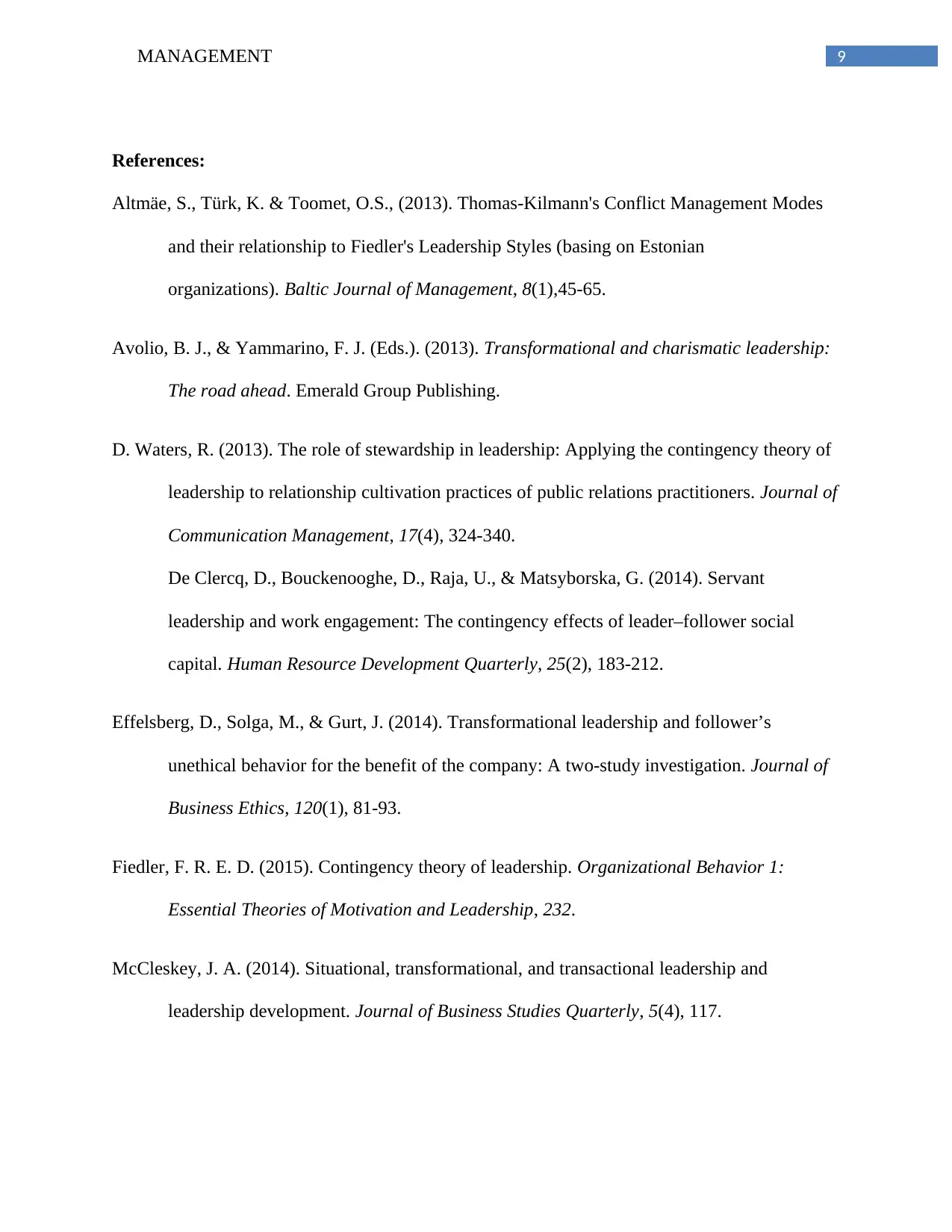
9MANAGEMENT
References:
Altmäe, S., Türk, K. & Toomet, O.S., (2013). Thomas-Kilmann's Conflict Management Modes
and their relationship to Fiedler's Leadership Styles (basing on Estonian
organizations). Baltic Journal of Management, 8(1),45-65.
Avolio, B. J., & Yammarino, F. J. (Eds.). (2013). Transformational and charismatic leadership:
The road ahead. Emerald Group Publishing.
D. Waters, R. (2013). The role of stewardship in leadership: Applying the contingency theory of
leadership to relationship cultivation practices of public relations practitioners. Journal of
Communication Management, 17(4), 324-340.
De Clercq, D., Bouckenooghe, D., Raja, U., & Matsyborska, G. (2014). Servant
leadership and work engagement: The contingency effects of leader–follower social
capital. Human Resource Development Quarterly, 25(2), 183-212.
Effelsberg, D., Solga, M., & Gurt, J. (2014). Transformational leadership and follower’s
unethical behavior for the benefit of the company: A two-study investigation. Journal of
Business Ethics, 120(1), 81-93.
Fiedler, F. R. E. D. (2015). Contingency theory of leadership. Organizational Behavior 1:
Essential Theories of Motivation and Leadership, 232.
McCleskey, J. A. (2014). Situational, transformational, and transactional leadership and
leadership development. Journal of Business Studies Quarterly, 5(4), 117.
References:
Altmäe, S., Türk, K. & Toomet, O.S., (2013). Thomas-Kilmann's Conflict Management Modes
and their relationship to Fiedler's Leadership Styles (basing on Estonian
organizations). Baltic Journal of Management, 8(1),45-65.
Avolio, B. J., & Yammarino, F. J. (Eds.). (2013). Transformational and charismatic leadership:
The road ahead. Emerald Group Publishing.
D. Waters, R. (2013). The role of stewardship in leadership: Applying the contingency theory of
leadership to relationship cultivation practices of public relations practitioners. Journal of
Communication Management, 17(4), 324-340.
De Clercq, D., Bouckenooghe, D., Raja, U., & Matsyborska, G. (2014). Servant
leadership and work engagement: The contingency effects of leader–follower social
capital. Human Resource Development Quarterly, 25(2), 183-212.
Effelsberg, D., Solga, M., & Gurt, J. (2014). Transformational leadership and follower’s
unethical behavior for the benefit of the company: A two-study investigation. Journal of
Business Ethics, 120(1), 81-93.
Fiedler, F. R. E. D. (2015). Contingency theory of leadership. Organizational Behavior 1:
Essential Theories of Motivation and Leadership, 232.
McCleskey, J. A. (2014). Situational, transformational, and transactional leadership and
leadership development. Journal of Business Studies Quarterly, 5(4), 117.
Secure Best Marks with AI Grader
Need help grading? Try our AI Grader for instant feedback on your assignments.
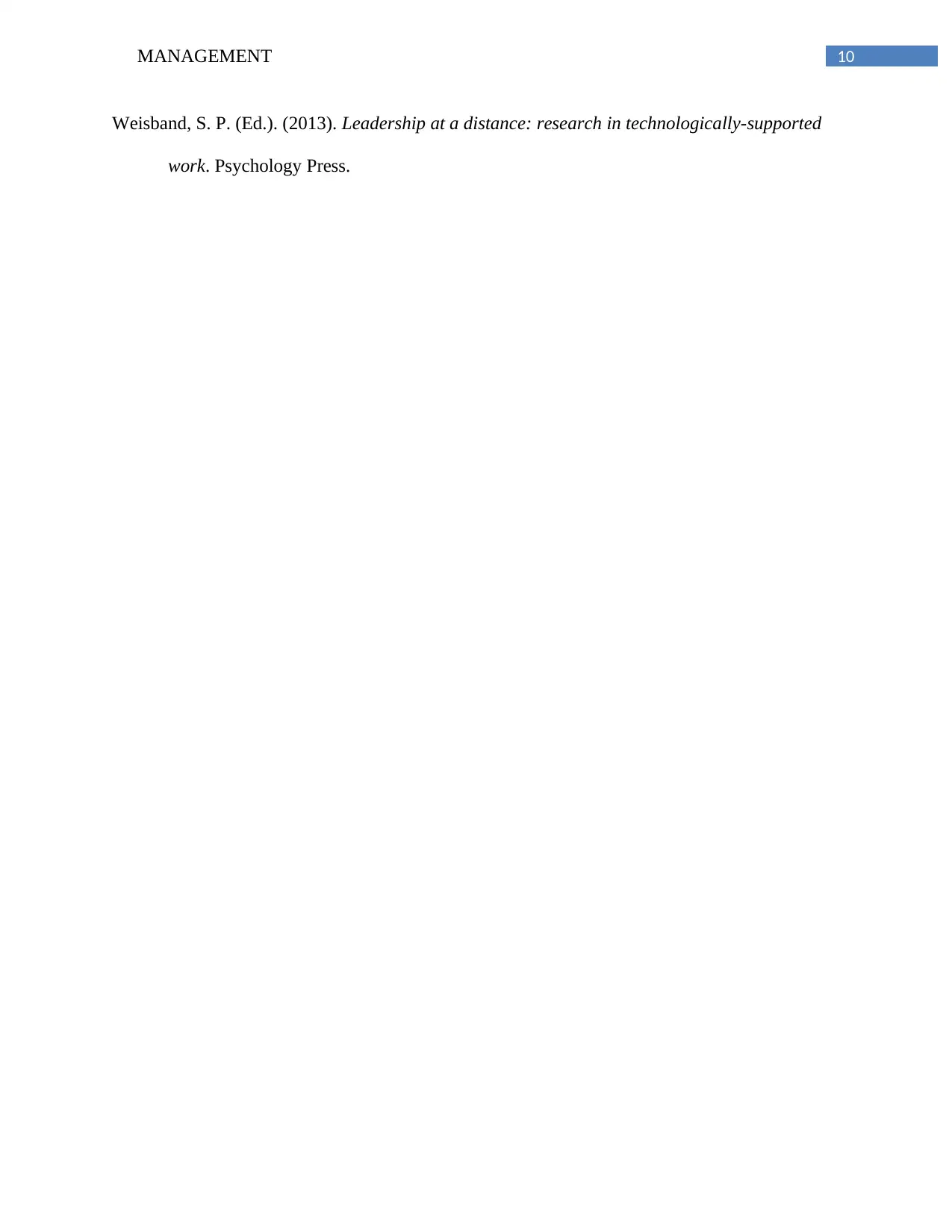
10MANAGEMENT
Weisband, S. P. (Ed.). (2013). Leadership at a distance: research in technologically-supported
work. Psychology Press.
Weisband, S. P. (Ed.). (2013). Leadership at a distance: research in technologically-supported
work. Psychology Press.
1 out of 11
Related Documents
Your All-in-One AI-Powered Toolkit for Academic Success.
+13062052269
info@desklib.com
Available 24*7 on WhatsApp / Email
![[object Object]](/_next/static/media/star-bottom.7253800d.svg)
Unlock your academic potential
© 2024 | Zucol Services PVT LTD | All rights reserved.





